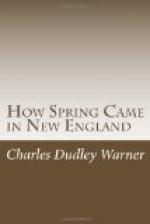Say, rather, the usual thing is about to occur. There is a wind called Auster, another called Eurus, another called Septentrio, another Meridies, besides Aquilo, Vulturnus, Africus. There are the eight great winds of the classical dictionary,—arsenal of mystery and terror and of the unknown,—besides the wind Euroaquilo of St. Luke. This is the wind that drives an apostle wishing to gain Crete upon the African Syrtis. If St. Luke had been tacking to get to Hyannis, this wind would have forced him into Holmes’s Hole. The Euroaquilo is no respecter of persons.
These winds, and others unnamed and more terrible, circle about New England. They form a ring about it: they lie in wait on its borders, but only to spring upon it and harry it. They follow each other in contracting circles, in whirlwinds, in maelstroms of the atmosphere: they meet and cross each other, all at a moment. This New England is set apart: it is the exercise-ground of the weather. Storms bred elsewhere come here full-grown: they come in couples, in quartets, in choruses. If New England were not mostly rock, these winds would carry it off; but they would bring it all back again, as happens with the sandy portions. What sharp Eurus carries to Jersey, Africus brings back. When the air is not full of snow, it is full of dust. This is called one of the compensations of Nature.
This is what happened after the convention of the blackbirds: A moaning south wind brought rain; a southwest wind turned the rain to snow; what is called a zephyr, out of the west, drifted the snow; a north wind sent the mercury far below freezing. Salt added to snow increases the evaporation and the cold. This was the office of the northeast wind: it made the snow damp, and increased its bulk; but then it rained a little, and froze, thawing at the same time. The air was full of fog and snow and rain. And then the wind changed, went back round the circle, reversing everything, like dragging a cat by its tail. The mercury approached zero. This was nothing uncommon. We know all these winds. We are familiar with the different “forms of water.”
All this was only the prologue, the overture. If one might be permitted to speak scientifically, it was only the tuning of the instruments. The opera was to come,—the Flying Dutchman of the air.
There is a wind called Euroclydon: it would be one of the Eumenides; only they are women. It is half-brother to the gigantic storm-wind of the equinox. The Euroclydon is not a wind: it is a monster. Its breath is frost. It has snow in its hair. It is something terrible. It peddles rheumatism, and plants consumption.
The Euroclydon knew just the moment to strike into the discord of the weather in New England. From its lair about Point Desolation, from the glaciers of the Greenland continent, sweeping round the coast, leaving wrecks in its track, it marched right athwart the other conflicting winds, churning them into a fury, and inaugurating chaos. It was the Marat of the elements. It was the revolution marching into the “dreaded wood of La Sandraie.”




